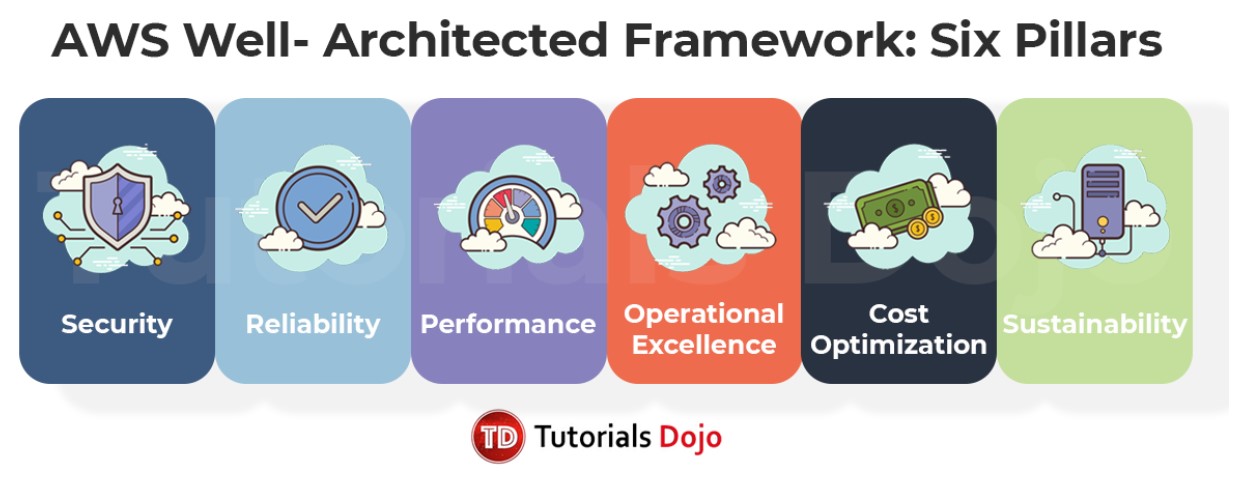- The ability to run and monitor systems to deliver business value and to continually improve supporting processes and procedures.
- There are four best practice areas and tools for operational excellence in the cloud:
- Organization – AWS Cloud Compliance, AWS Trusted Advisor, AWS Organization.
- Having well-architected systems greatly increases the plausibility of business success which is why AWS created the AWS Well-Architected Framework. This framework is composed of six pillars that help you understand the pros and cons of decisions you make while building cloud architectures and systems on the AWS platform. You will learn the architectural best practices for designing and operating reliable, efficient, cost-effective and secure systems in the cloud by using the framework. It also provides a way to consistently measure your architectures against best practices and identify areas for improvement.

1. Operational Excellence
- The ability to run and monitor systems to deliver business value and to continually improve supporting processes and procedures.
- There are four best practice areas and tools for operational excellence in the cloud:
- Organization – AWS Cloud Compliance, AWS Trusted Advisor, AWS Organizations
- Prepare – AWS Config
- Operate – Amazon CloudWatch
- Evolve – Amazon Elasticsearch Service
- Key AWS service:
- AWS CloudFormation for creating templates. (See AWS Management Tools Cheat Sheet)
2. Security
- The ability to protect information, systems, and assets while delivering business value through risk assessments and mitigation strategies.
- There are six best practice areas and tools for security in the cloud:
- Security – AWS Shared Responsibility Model, AWS Config, AWS Trusted Advisor
- Identity and Access Management – IAM, Multi-Factor Authentication, AWS Organizations
- Detective Controls – AWS CloudTrail, AWS Config, Amazon GuardDuty
- Infrastructure Protection – Amazon VPC, Amazon CloudFront with AWS Shield, AWS WAF
- Data Protection – ELB, Amazon Elastic Block Store (Amazon EBS), Amazon S3, and Amazon Relational Database Service (Amazon RDS) encryption, Amazon Macie, AWS Key Management Service (AWS KMS)
- Incident Response – IAM, Amazon CloudWatch Events
- Key AWS service:
- AWS Identity and Access Management (IAM)
3. Reliability
- The ability of a system to recover from infrastructure or service disruptions, dynamically acquire computing resources to meet demand, and mitigate disruptions such as misconfigurations or transient network issues.
- There are four best practice areas and tools for reliability in the cloud:
- Foundations – IAM, Amazon VPC, AWS Trusted Advisor, AWS Shield
- Change Management – AWS CloudTrail, AWS Config, Auto Scaling, Amazon CloudWatch
- Failure Management – AWS CloudFormation, Amazon S3, AWS KMS, Amazon Glacier
- Workload Architecture – AWS SDK, AWS Lambda
- Key AWS service:
- Amazon CloudWatch
4. Performance Efficiency
- The ability to use computing resources efficiently to meet system requirements, and to maintain that efficiency as demand changes and technologies evolve.
- There are four best practice areas for performance efficiency in the cloud:
- Selection – Auto Scaling for Compute, Amazon EBS and S3 for Storage, Amazon RDS and DynamoDB for Database, Route53, VPC, and AWS Direct Connect for Network
- Review – AWS Blog and What’s New section of the website
- Monitoring – Amazon CloudWatch
- Tradeoffs – Amazon Elasticache, Amazon CloudFront, AWS Snowball, Amazon RDS read replicas.
- Key AWS service:
- Amazon CloudWatch
5. Cost Optimization
- The ability to avoid or eliminate unneeded cost or suboptimal resources.
- There are five best practice areas and tools for cost optimization in the cloud:
- Cloud Financial Management – Amazon QuickSight, AWS Cost and Usage Report (CUR)
- Cost-Effective Resources – Cost Explorer, Amazon CloudWatch and Trusted Advisor, Amazon Aurora for RDS, AWS Direct Connect with Amazon CloudFront
- Matching supply and demand – Auto Scaling
- Expenditure Awareness – AWS Cost Explorer, AWS Budgets
- Optimizing Over Time – AWS News Blog and the What’s New section on the AWS website, AWS Trusted Advisor
- Key AWS service:
- Cost Explorer
6. Sustainability
- The ability to increase efficiency across all components of a workload by maximizing the benefits from the provisioned resources.
- There are six best practice areas for sustainability in the cloud:
- Region Selection – AWS Global Infrastructure
- User Behavior Patterns – Auto Scaling, Elastic Load Balancing
- Software and Architecture Patterns – AWS Design Principles
- Data Patterns – Amazon EBS, Amazon EFS, Amazon FSx, Amazon S3
- Hardware Patterns – Amazon EC2, AWS Elastic Beanstalk
- Development and Deployment Process – AWS CloudFormation
- Key AWS service:
- Amazon EC2 Auto Scaling

No comments:
Post a Comment